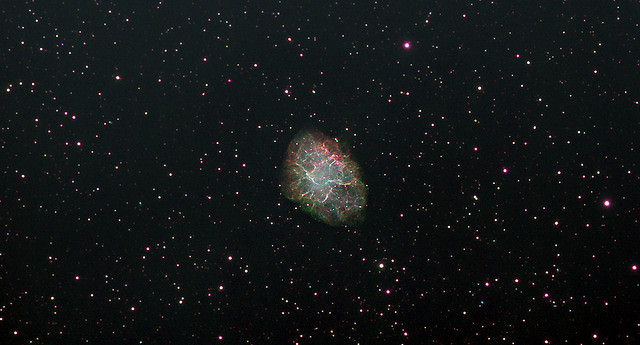Crab Nebula in a widefield, narrowband image. Credit: Nick Howes
This gorgeous shot of the Crab Nebula, or M1, by astronomer Nick Howes shows the famous nebula in a different light than the usual full spectrum views we’ve seen from the likes of the Hubble Space Telescope. Narrowband filters are designed to capture specific wavelengths of light, and since the Crab Nebula is emitting its own light rather than reflecting light from another source, it is a perfect candidate for imaging in narrow, or a limited part of the spectrum.
This nebula is the wreckage of an exploded star that emitted light which reached Earth in the year 1054. It is located 6,500 light-years away in the constellation Taurus. At the heart of an expanding gas cloud lies what is left of the original star’s core, a superdense neutron star that spins 30 times a second. With each rotation, the star swings intense beams of radiation toward Earth, creating the pulsed emission characteristic of spinning neutron stars (also known as pulsars).
Want to get your astrophoto featured on Universe Today? Join our Flickr group or send us your images by email (this means you’re giving us permission to post them). Please explain what’s in the picture, when you took it, the equipment you used, etc.


Beautiful image. Love wide-field views of familiar objects — celestial or terrestrial. They give context to the subjects place in the big picture, starscape or landscape. No close up view should be lacking a wide-field overview.
It can be annoying when news media, or documentary film, fail to show the broader surroundings of an event, or subject. When they do, it always enhances the reality of its unfolding details, gives frame to the object of lens.
Would be nice to know what narrowband filters were used (H-alpha, OIII and SII is a popular combination, for example).